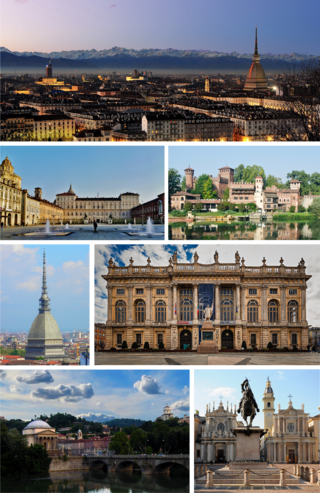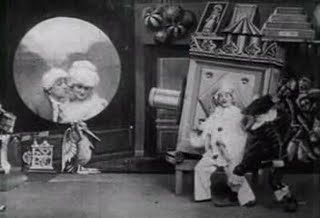Exhibition
The museum houses pre-cinematographic optical devices such as magic lanterns, earlier and current film technologies, stage items from early Italian movies and other memorabilia.
Along the exhibition path of about 35.000 square feet (3.200 m2) on five levels, it is possible to visit some areas devoted to the different kinds of film crew, and in the main hall, fitted in the temple hall of the Mole (which was a building originally intended as a synagogue), a series of chapels representing several film genres.
The museum keeps a huge and growing collection of film posters, stocks, and a library: at present it includes 20,000 devices, paintings and printed artworks, more than 80,000 pictures, over 300,000 film posters, 12,000 movie reels and 26,000 books (as of February 2006). A movie screen located in the Massimo multiplex, near to the museum, is reserved to retrospectives and other museum initiatives. The museum hosts several film festivals, the major and most prestigious of them being the Torino Film Festival.
Inside the museum there is also a panoramic elevator (opened in 2000) with transparent glass walls, that cover its 75 meters ride in 59 seconds, in the single open space span of the building, without middle floors, up to the "small temple" which gives a 360 degrees panoramic view of the city. It is the museum with the biggest vertical extension of the world.

The Mole Antonelliana is a major landmark building in Turin, Italy, named after its architect, Alessandro Antonelli. A mole in Italian is a building of monumental proportions.

The National Archaeological Museum of Naples is an important Italian archaeological museum, particularly for ancient Roman remains. Its collection includes works from Greek, Roman and Renaissance times, and especially Roman artifacts from the nearby Pompeii, Stabiae and Herculaneum sites. From 1816 to 1861, it was known as Real Museo Borbonico.

Borsalino is the oldest Italian company specializing in the manufacture of luxury hats. Since 1857, the manufacture has been based in Alessandria, Piedmont. The founder, Giuseppe Borsalino, is remembered for creating a particular model of felt hat characterized by the registered trademark Borsalino.

Precursors of film are concepts and devices that have much in common with the later art and techniques of cinema.

The National Roman Museum is a museum, with several branches in separate buildings throughout the city of Rome, Italy. It shows exhibits from the pre- and early history of Rome, with a focus on archaeological findings from the period of Ancient Rome.

The National Museum of the Italian Risorgimento is the first, the biggest and the most important among the 23 museums in Italy dedicated to the Risorgimento; and the only one which can be considered "national" according to a 1901 law, and due to its rich and great collections. It is housed in the Palazzo Carignano in Turin.

Turin is a city and an important business and cultural centre in Northern Italy. It is the capital city of Piedmont and of the Metropolitan City of Turin, and was the first Italian capital from 1861 to 1865. The city is mainly on the western bank of the Po River, below its Susa Valley, and is surrounded by the western Alpine arch and Superga hill. The population of the city proper is 847,287, while the population of the urban area is estimated by Eurostat to be 1.7 million inhabitants. The Turin metropolitan area is estimated by the OECD to have a population of 2.2 million.
Angelo Cesselon was an Italian poster painter.

The Museo Nazionale della Magna Grecia, Museo Archeologico Nazionale di Reggio Calabria or Palazzo Piacentini is a museum in Reggio Calabria, southern Italy, housing an archaeological collection from sites in Magna Graecia.

The Museum of Precinema is a museum in the Palazzo Angeli, Prato della Valle, Padua, Italy, related to the history of precinema, or precursors of film. It was created in 1998 to display the Minici Zotti Collection, in collaboration with the Comune di Padova. It also produces interactive touring exhibitions and makes valuable loans to other prestigious exhibitions such as 'Lanterne magique et film peint' at the Cinémathèque Française in Paris and the Museum of Cinema in Turin.
The following is a timeline of the history of the city of Turin, Piedmont, Italy.
Elävän kuvan museo was a museum dedicated to Finnish film culture located in Helsinki, Finland. The museum was operated by the National Audiovisual Institute.

The Museo Storico Nazionale dell'Arte Sanitaria is located within the Ospedale di Santo Spirito in Sassia at 3, Lungotevere in Sassia in Rome (Italy).

The Turin Civic Gallery of Modern and Contemporary Art is an art gallery in Turin, Italy, founded in 1891-1895 and located in 31 via Magenta. With the MAO, Palazzo Madama e Casaforte degli Acaja, the Borgo and the Rocca medioevali, it forms part of the Fondazione Torino Musei. The lower rooms house important reviews and a large collection of video art.

La Lanterne magique, sold in the United States as The Magic Lantern and in Britain as The Magic Lantern, or the Bioscope in the Toy Shop, is a 1903 French short silent film by Georges Méliès. It was sold by Méliès's Star Film Company and is numbered 520–524 in its catalogues.

The Museo Leonardiano di Vinci, or Leonardian Museum of Vinci, is a museum dedicated to Leonardo da Vinci, located in Vinci, Leonardo's birthplace, in the province of Florence, Italy.

Maria Adriana Prolo (1908–1991) was a historian of Italian film. She studied pioneering narratives in silent film, founded the National Museum of Cinema in Turin, and was an active member of International Federation of Film Archives. She was one of the first people, with Einar Lauritzen and Henri Langlois, to have the idea of founding a museum dedicated to film and its conservation.







































